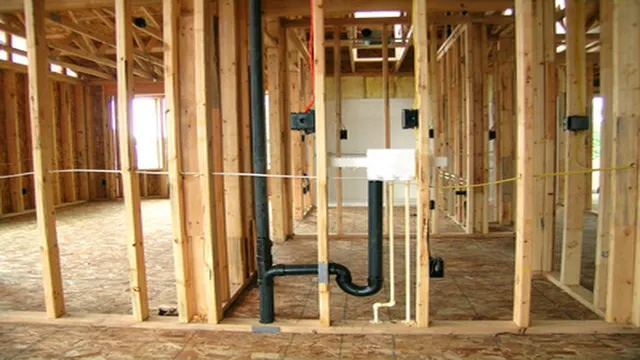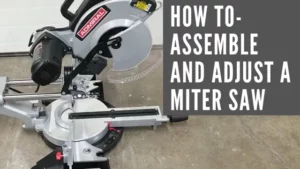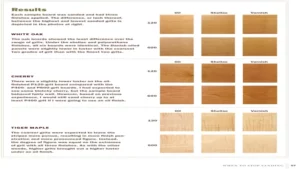Have you ever wondered what the proper size hole for Romex is? Choosing the right size hole is crucial to ensure that your electrical wiring is secure and safe. Making a hole that is too small can damage the Romex, and making a hole that is too large can compromise the stability of the wiring. In this comprehensive guide, we’ll cover everything you need to know about choosing the proper size hole for Romex.
Whether you’re a DIY enthusiast or a seasoned electrician, this guide will provide valuable information to help you avoid common mistakes and ensure a successful electrical project. So, let’s dive in and explore the world of Romex and hole sizing!
What is Romex?
If you’re planning on installing electrical wiring, you might have heard the term “Romex” thrown around. Romex refers to a type of electrical cable that’s commonly used in residential applications to power outlets, switches, and lights. Romex typically consists of two or three insulated wires (depending on whether it’s 12- or 14-gauge) sheathed together in a single jacket.
The jacket is a key feature of Romex since it protects the wiring from damage and helps to prevent electrical shock. When it comes to drilling holes for Romex, you’ll need to make sure that the hole is big enough to accommodate the cable without damaging it. For 12-gauge Romex, the National Electric Code (NEC) recommends a minimum hole size of ¾ inch, while for 14-gauge Romex, a minimum hole size of ⅝ inch is sufficient.
It’s important to make sure that the Romex is not pinched or crushed by the hole, as this can cause damage to the insulation and create a potential safety hazard.
Definition of Romex
Romex is a type of electrical cable that is commonly used in residential wiring. Also known as Non-Metallic Sheathed Cable (NM), it consists of two or three insulated conductors housed in a plastic sheathing. The sheathing not only protects the conductors from damage and moisture but also provides some level of insulation.
Romex comes in different sizes and configurations, with the most popular being 12/2 and 14/2, indicating the gauge of the wires. This type of cable is widely used for branch circuits, which are the electrical connections that power everything from lights to outlets in your home. Romex is easy to install, affordable, and meets the national electrical code for residential wiring.
However, it’s important to note that certain restrictions may apply to its usage, as it’s not allowed in certain commercial or industrial applications. So, if you’re planning on doing any DIY wiring, Romex is definitely worth considering as long as you stay within its guidelines.

Types of Romex Cables
Romex is a brand of electrical cable that is commonly used in residential and commercial buildings. It is a type of non-metallic sheathed cable, which means that it is made up of several different layers of material that provide both insulation and protection. Romex cables come in a variety of sizes and configurations, depending on their intended use.
The most common types of Romex cables include 14/2, 12/2, and 10/2, which are commonly used for lighting and general power circuits. Larger Romex cables, such as 6/3 and 8/3, are often used for high-powered appliances like electric stoves and dryers. When selecting a Romex cable, it is important to consider the size of the cable as well as the type of insulation and protection it provides.
The right Romex cable can help ensure that your electrical system is safe and reliable, no matter what your needs may be.
Why is the Hole Size Important?
If you’re planning on running Romex cable in your home, it’s essential to consider the size of the hole you’ll need. The hole size is important because it directly affects how secure and safe your wiring will be. If the hole is too small, it can damage the cable as you pull it through, causing your wiring to become loose and potentially dangerous.
On the other hand, if the hole is too big, it can leave too much play in the wiring, leading to issues with the cable becoming tangled or damaged over time. Additionally, if the hole is too large, there is a risk of damage to the surrounding building materials. Therefore, it’s important to select a hole size that is suitable for the Romex cable you’re using.
The size of the hole will typically depend on the diameter of the cable and the building materials you’re working with. By taking the time to properly size your hole and ensure your wiring is installed correctly, you can help ensure the safety and longevity of your home’s electrical system.
Safety Concerns
When it comes to safety concerns, it’s essential to pay attention to the size of the hole. Why? Because it directly impacts the safety and well-being of people around the area. If the hole is too small, it won’t allow enough ventilation and can result in poor air quality, while if the hole is too big, it can lead to accidents and injuries.
It’s important to consider all factors, like the size of the area, the amount of ventilation required, and the weight-bearing capacity of the material. By doing so, you can ensure that the hole size is just right, and you avoid any potential safety hazards. So when it comes to drilling or creating a hole, always remember the importance of size and how it can affect safety.
Code Compliance
Code compliance is a crucial aspect in any construction project, ensuring that they meet safety standards and regulations set by authorities. When it comes to installing electrical wires or conduits, the hole size is an important factor. The National Electrical Code (NEC) provides guidelines that govern the size of the hole to be drilled into wood, metal, and other materials to accommodate wires and cables.
This is essential as it prevents damage to the wires during installation and ensures that they are adequately secured in place. The size of the hole should also comply with the wire fill capacity for a given conduit size to guarantee that the installation is safe and will not overload the conduit. Failure to adhere to these guidelines can result in code violations, putting the project at risk of being shut down or fined.
Therefore, it is essential to verify that the size of the hole being drilled is in compliance with the guidelines to avoid any potential safety risks.
How to Determine the Right Hole Size for Romex?
When it comes to wiring your home, choosing the right size hole for Romex is crucial for safety and efficiency. The National Electrical Code (NEC) provides guidelines to ensure proper installation of electrical wiring, including the size of the hole needed for Romex cables. The NEC recommends that the hole size be at least one-quarter inch larger than the diameter of the cable.
For example, if you are installing 12/2 Romex, which has a diameter of approximately 0.43 inches, you would need to use a hole saw with a diameter of at least 0.68 inches.
This allows for easy installation without damaging or compressing the cable. It also allows for proper ventilation and prevents overheating, which can lead to fire hazards. Always follow NEC guidelines and consult a licensed electrician if you are unsure about the proper hole size for Romex or any other electrical installation.
Factors to Consider
Determining the right hole size for Romex may seem daunting at first, but with a little bit of knowledge and practice, it can be done easily. The size of the hole depends on several factors, the most important of which are the size of the cable and the type of material the cable is running through. Generally, the hole size should be about 1/8 inch larger than the diameter of the Romex cable.
However, this varies depending on the thickness of the insulation and the material through which the cable is running. It is important to carefully measure and test the size before drilling to avoid damaging the cable or creating an unsafe environment. By taking the time to consider these factors, you can ensure that your Romex cable is safely installed and properly secured.
Calculation Methods
Determining the right hole size for Romex can be a crucial step in any electrical wiring project. Luckily, there are some simple calculation methods you can use to make sure you get it right. Firstly, you’ll want to examine the Romex cable you’ll be working with, as the diameter of the cable will determine the hole size you need.
To calculate this, add the diameter of the cable with the outer jacket to the diameter of the two conductors. Then, add 1/4 inch to accommodate for any movement. Another method involves measuring the cable and matching it to a drill bit of the same size.
It’s important to note that the hole should not be too tight or too loose, as a tight hole can damage the cable and a loose one can leave it vulnerable to abrasion. With these methods in mind, you can confidently determine the perfect hole size for your Romex project.
Recommended Hole Sizes for Different Romex Cables
When it comes to installing Romex cables, having the correct size hole is crucial to ensure a safe and secure installation. The size of the hole you need to drill will vary depending on the size of the Romex cable you’re working with. For example, if you’re working with 14/2 Romex cable, you’ll need a 1 3/8 inch hole, while a 12/3 Romex cable requires a 1 5/8 inch hole.
Using the wrong size hole can cause damage to the cable, making it prone to fraying or overheating, which can be dangerous. It’s essential that you refer to a manufacturers’ guide or consult with an electrician to determine the appropriate hole size for the type of Romex cable you are working with. Taking the time to ensure that you have the right size hole will help you avoid costly mistakes and keep your installation safe and secure.
Remember, safety always comes first, so don’t take any shortcuts when it comes to installing Romex cables.
Table of Hole Sizes for Romex Cables
Romex cables Romex cables are a popular choice for residential electrical wiring due to their durability and easy installation. When it comes to drilling holes for these cables, it’s important to use the correct size to prevent damage to the cable and ensure it fits properly. The recommended hole size for 14/2 Romex cables is 7/8 inches, while 12/2 Romex cables require a slightly larger hole at 1 inch.
For 10/2 Romex cables, the recommended hole size is 1 1/8 inches. Keep in mind that it’s always better to use a hole that’s slightly larger rather than smaller, as a tight fit can damage the cable and pose a safety hazard. Before you start drilling, be sure to check your local building codes to ensure you’re using the proper size for your area.
By using the correct hole size, you can ensure your Romex cables are installed safely and securely.
Conclusion and Safety Tips
In the eternal quest for the perfect size hole for Romex, one can get lost in a sea of opinions and debates. However, in the end, it all boils down to a simple principle – just big enough to fit the wire, but not so big that it rattles around like a snake in a can. So, remember folks, when in doubt, measure twice and cut once – or risk being shocked by your own lack of planning!”
FAQs
What size hole should I drill for Romex cables?
The size of the hole to be drilled for Romex cables should be at least 1 ¼ inch in diameter. This is to ensure that the cable can move freely and is not pinched or damaged during installation.
Is it safe to drill through walls when installing Romex cables?
Yes, it is safe to drill through walls when installing Romex cables as long as proper precautions are taken. Ensure that there are no electrical wires, plumbing, or structural supports behind the wall before drilling. Use a stud finder and drill slowly to avoid damaging any wires.
Can I run Romex cables in conduit?
It is not recommended to run Romex cables in conduit as it is designed to be used without a conduit. Running Romex cables in conduit can cause overheating and a potential fire hazard.
How many Romex cables can I run through a single hole?
The number of Romex cables that can be run through a single hole depends on the size of the hole and the size of the cables. It is recommended to not exceed three cables in a single hole.
Can Romex cables be exposed in a garage?
Yes, Romex cables can be exposed in a garage as long as they are protected by a running board or conduit. This is to prevent damage from vehicles or other objects that may come in contact with the cables.
Do I need a special tool to cut Romex cables?
No, a special tool is not required to cut Romex cables. A sharp utility knife or wire cutters can be used to cut the cables to the desired length.
Can Romex cables be used in outdoor installations?
Romex cables are not designed for outdoor installations and are not rated for exposure to outdoor environments. It is recommended to use a different type of cable that is specifically designed for outdoor use.






